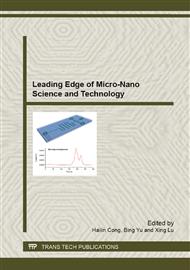[1]
László Juhász, Jürgen Maas, Branislav Borovac, Parameter identification and hysteresis compensation of embedded piezoelectric stack actuators, Mechatronics. 21 (2011) 329–338.
DOI: 10.1016/j.mechatronics.2010.12.006
Google Scholar
[2]
Gorka Aguirre, ThierryJanssens, HendrikVanBrussel, FaridAl-Bender, Asymmetric-hysteresis compensation in piezoelectric actuators, Mechanical Systems and Signal Processing. 30 (2012) 218–231.
DOI: 10.1016/j.ymssp.2011.11.012
Google Scholar
[3]
Jonq-Jer Tzen, Shyr-Long Jeng, Wei-Hua Chieng , Modeling of piezoelectric actuator for compensation and controller design, Precision Engineering. 27 (2003) 70–86.
DOI: 10.1016/s0141-6359(02)00183-6
Google Scholar
[4]
De Ping Yu, Geok Soon Hong, Yoke San Wong,Profile error compensation in fast tool servo diamond turning of micro-structured surfaces, International Journal of Machine Tools & Manufacture. 52 (2012) 13–23.
DOI: 10.1016/j.ijmachtools.2011.08.010
Google Scholar
[5]
L. Jacob, N. Jerry, Stressed-lap Polishing of 3. 6m f/1. 5 and f/1. 0 Mirror. SPIE, 1991, 1531: 260-269.
Google Scholar
[6]
Jeong-Du Kim, Dong-Sik Kim, Waviness compensation of precision machining by piezoelectric micro cutting device, International Journal of Machine Tools & Manufacture. 38 (1998) 1305-1322.
DOI: 10.1016/s0890-6955(97)00080-1
Google Scholar
[7]
Hartmut Janocha, Klaus Kuhnen, Real-time compensation of hysteresis and creep in piezoelectric actuators, Sensors and Actuators. 79 (2000)83–89.
DOI: 10.1016/s0924-4247(99)00215-0
Google Scholar
[8]
G.J. Trmal, F. Holesovsky, Wave-shift and its effect on surface quality in super-abrasive grinding, International Journal of Machine Tools & Manufacture. 41 (2001) 979–989.
DOI: 10.1016/s0890-6955(00)00116-4
Google Scholar
[9]
K. Ramesh, H. Huang, L. Yin, and A. Yui, Surface Waviness Controlled Grinding of Thin Mold Inserts Using Chilled Air as Coolant, Materials and Manufacturing Processes Vol. 19, No. 2, p.341–354, (2004).
DOI: 10.1081/amp-120029959
Google Scholar
[10]
Wen-Ruey Chang, Raoul Gro Nqvist, Mikko Hirvonen and Simon Matz, The effect of surface waviness on friction between Neolite and quarry tiles , Ergonomics, 22 June, 2004, Vol. 47, No. 8, 890-906.
DOI: 10.1080/00140130410001670390
Google Scholar
[11]
Georgios P. Petropoulos, Constantinos N. Pandazaras, J. Paulo Davim, Surface Integrity in Machining, Springer London, 2010, pp.37-66.
DOI: 10.1007/978-1-84882-874-2_2
Google Scholar
[12]
Demirci, S. Mezghani, A. Mkaddem, M. El Mansori, Effects of abrasive tools on surface finishing under brittle-ductile grinding regimes when manufacturing glass, Journal of Materials Processing Technology. 210 (2010) 466-473.
DOI: 10.1016/j.jmatprotec.2009.10.009
Google Scholar
[13]
Jeong-du Kim, Dal-ho Lee, Keun-bum Lee, The effects of dynamic characteristics on the surface texture in mirror grinding, Int J Adv Manuf Technol. 27(2005): 274–280.
DOI: 10.1007/s00170-004-2177-5
Google Scholar
[14]
Chunsheng Zhao, Ultrasonic motors Technologies and Applications, Science Press Beijing and Springer-Verlag Berlin Heidelberg, 2011, pp.38-47.
Google Scholar
[15]
Jin Jiamei, Zhao Chunsheng, A novel traveling wave ultrasonic motor using a bar shaped transducer. Journal of wuhan university of technology[J]. Materials Science Edition. 2008, 23: 961-963.
DOI: 10.1007/s11595-008-6961-1
Google Scholar
[16]
Chao Chen, Jinsong Zeng, Chunsheng Zhao, Dynamic model of traveling wave-type rotary ultrasonic motor, Chinese Journal of Mechanical Engineering . 2006 , 42(12): 76-28.
DOI: 10.3901/jme.2006.12.076
Google Scholar
[17]
Jin Jiamei, Zhang Jiahui, Qian fu, Pan zhenfeng, Improving the Performances of Ultrasonic Motors Using Intermittent Contact Scheme, Front. Mech. Eng. China. 2010, 5(2), pp.242-246.
DOI: 10.1007/s11465-010-0016-y
Google Scholar
[18]
Nicola Senin and Gianni Campatelli, Springer-Verlag London, 2011, pp.71-110.
Google Scholar


